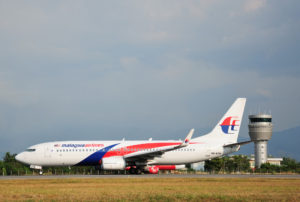
Photo: 123RF
A Malaysia Airlines Boeing 737
What happens if a pilot falls asleep on a long flight?
On 15 August 2022, two Ethiopian Airlines pilots flying a Boeing 737 missed landing after reportedly falling asleep. They could not be contacted by the air traffic controller but were awakened by an on-board alarm. They were suspended pending an investigation.
When on flying duties, all flight crew members are expected to be awake. Each pilot is supposed to keep an eye on the other one
I have heard stories of pilots who took illegal catnaps, then woke up to find that the other one had been asleep too!
When I flew the Boeing 777, I remember the plane had an anti-dozing alarm known as the ‘Flight Crew Response Monitor’.
It is a feature that relays alerts and aural warnings if no cockpit switch is sensed for over 20 minutes.
This device would trigger a silent visual advisory alert first and if no cockpit activity is felt, a loud continuous warning is activated. This would guarantee to wake up the pilot under any circumstance!
According to a NASA study on fatigue, tired people can experience brief periods of ‘micro sleep’ or even minutes-long lapses when the eyes are open but the brain is on hold. This is not what you want when your tired pilot is flying a demanding approach at the end of an eight-hour flight.
They have also found that naps of up to 40 minutes are both safe and effective for pilots on trips of more than seven hours.
However, FAA have decided not to pursue this idea vigorously due to the potential litigious suits that could arise should an accident occur while a pilot was napping.
The way around this is to define such shut-eye activity as a ‘controlled rest’. For this to happen, there are stringent rules to be followed. Once all safeguards are satisfied then only pilots are permitted to sleep during flight to mitigate fatigue.
Not all airlines permit this on long flights. When allowed, they are usually seen on flights of up to eight hours with two-man crew. Such naps should only occur during non-critical stages of the flight. They are not allowed during any planned changes of flight levels, having to perform any fuel transfer or at a period when there is a forecast of bad weather.
Additionally, the autopilot must be switched on, the flight attendants must be informed of the pilot’s intention and the other pilot must be fully awake and to always remain in his seat.
A flight attendant must check-in over the intercom with the nonsleeping pilot every 15 minutes or so to ensure everything is normal.
Once all the safety procedures have been addressed, only then can the pilot take a nap of about 20 to 40 minutes in his cockpit seat.
To answer the question, what happens if a pilot falls asleep on a long flight, well the pilot is likely to be suspended unless the controlled-rest procedure is practiced by the airlines.
View YouTube video on Ethiopian Airlines pilots reportedly fell asleep during flight